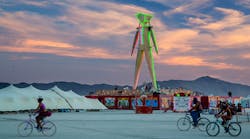Every August, thousands of people travel to the Nevada desert to celebrate Burning Man, an event that celebrates free-thinking and self-expression. In the midst of those cultural guerillas area horde of computer geeks and Silicon Valley executives who take those experiences home and make them part their work cultures, according to Stanford communication Professor Fred Turner.
Turner is a communications professor at Stanford University who has studied Burning Man’s appeal within the tech industry for more than a decade. Here’s an interview with him conducted by Melisa De Witte for the Stanford News Service.
Why did you want to study Burning Man?
On my first visit to Google in Mountain View, I saw lots of pictures of Burning Man in the company’s lobby. I’ve found over the years that what companies put in their lobbies tends to say a lot about what kind of company they hope to be. And so, I started exploring the connections. I’m still doing that work today.
You’ve been researching Burning Man and tech culture for over a decade. What are some of the changes you’ve seen?
The tech industry and Burning Man have followed parallel trajectories in that both have become suffused with so much money that the countercultural impulses that drove some of the founders have become much harder to see. When I was attending Burning Man in the mid-2000s, which is still 20 years after it started, people went to great pains to make sure the playa was a brand-free environment. They taped over the logos on their U-Hauls, for instance, and staged anti-commercial art works of varying kinds. Some of that is still there, but the last time I went, two years ago, brands were everywhere, famous people were sleeping in camps that they’d paid others to build and maintain, and the original, anti-capitalist edge I remember had been ground down to the point of disappearing.
A lot of this can be said about the internet itself, of course. The utopian, extra-economic aspects of the early internet have morphed to bring us a system that has become for far too many people an ad-supported highway for delivering mainstream media goods. The virtual communities of the 1990s have become the ad-supported social media of the 2000s and the open conversation-based communities of the early web have become sites of commercial and government surveillance. And the gift economy has been monetized through and through.
In the 1990s everyone thought the internet would democratize public life. So why didn’t it? By the same token, early Burners designed the city on the playa to be a city outside mainstream society and now it’s visibly suffused by capital. More recently, reporters have noticed the corruption of the original countercultural intent and to call out some of the more egregious ways the wealthy have begun to buy their way into the event as one more carefully guided experience to check off their bucket lists.
What I’d want to study now, I think, is how systems designed for utopian ends lose their political mojo and why.
Fred Turner, professor of communication, sees reflections in Silicon Valley of the principles celebrated at the annual Burning Man festival in Nevada. (Image credit: Kathleen Hinkel)
In a 2009 paper, you wrote about Burning Man providing a cultural infrastructure for emerging forms of new media manufacturing. How so, and what does that look like today?
When I wrote the paper, I saw companies such as Google turning to Burners and collaborating with them to create and test new products, such as interactive mapping software. The collaborative, project-centered building and play Burning Man supports help build social and professional networks of folks who go home to Silicon Valley and make things.
I went back to Burning Man two years ago and the project-based social networking I had seen a decade earlier was omnipresent. It’s baked into the place. People travel to Burning Man to build and stay in camps together, and these camps provide the arts and services for the playa. We can see a city in the desert. Both the camps and the art are often technologically sophisticated, and they must be made in difficult conditions.
For example, I met a group of engineers who had built a complicated and technically advanced lighting strip. They invested a lot of money into the project and worked on it a year ahead of the festival. It required intense teamwork to set up the structure, especially in the harsh conditions on the playa.
The pleasure of working together intensely as a project-based team is also celebrated in Silicon Valley. I’ve seen Burning Man-like language infused in corporate statements, where tech workers are often described as “entrepreneurial team members” who work “intensely and ecstatically” on building something that will “change the world.” In the real world, they’re building a product for Apple and Google. But when they come together on the playa, they’re making artworks.
There’s also something about the way they’re working that reminds me of earlier American Protestants.
You describe Burning Man as a highly visible ritual in the Bay Area. Why does it appeal to tech workers and Silicon Valley workers?
Burning Man is to the contemporary tech world what the Protestant church was to industrial manufacturers. In the industrial era, you might work six days a week in a factory. On the seventh, you would go to church. The bosses would sit up front, the middle management right behind them, and the workers would fill out the pews. The church itself was a model of the factory, transformed into a spiritual community.
That’s how I think about Burning Man. Tech folks from Silicon Valley I’ve talked to described going out into the desert and building tech-centered art works and sophisticated camps. They describe the process as being something like product development: intense, high stakes, deadline-driven, and hard. At their day jobs, they are usually laboring to bring to life somebody else’s vision. But at Burning Man, they experience the kind of flow that is supposed to accompany engineering in the Valley on behalf of their own work. What they make in turn is highly visible; everybody sees everything on the playa and celebrates what they like.
In this way, Burning Man models the project-centered, team-oriented manufacturing practices that drive Silicon Valley, and at the same time reconfigures them as a collective spiritual exercise.
When I talked with people at Burning Man who work in Silicon Valley, they would tell me that they work really hard in their companies, but they are always fulfilling someone else’s vision. At Burning Man, they feel as if they are fulfilling their own vision.
What do you think of the media spectacle of the event?
Burning Man is designed to be photographed, talked about, circulated, watched. The playa is set up to be a media spectacle. It is a single, white dust stage, and everyone out there is fully aware they are acting in a kind of all-encompassing theater.
The first intellectual community with which I fell into scholarly love was the American Puritans. They dreamed they were trying to become saints in an America that was a desert, an America watched over by the all-seeing eye of God. When I began seeing pictures of what was happening on the playa, I couldn’t help but remember the Puritans’ vision of themselves.
All of this is deeply American. When the Pilgrims landed at Plymouth Rock, they thought they had arrived in a biblical desert. There they would build a model community and live lives of exemplary rectitude. Burning Man, too, is a model community, and its citizens are very clear that they are modelling a way of life that is as different from daily life in middle America as Puritan life was from the everyday world of the England they’d left behind.
In the 17th century, the Puritans performed under what they thought was the eye of God. Today, Burners dance for each other and for each other’s cameras. The Puritan god has fled the scene. Now we just watch each other.


